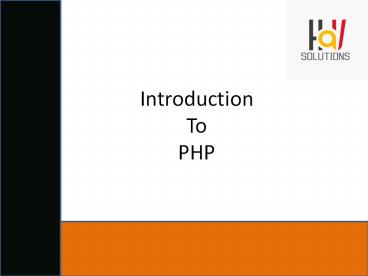introduction to PHP PowerPoint PPT Presentation
Title: introduction to PHP
1
Introduction ToPHP
2
- PHP originally stood for "Personal Home Page".
- The PHP Hypertext Preprocessor (PHP) is a
programming language that allows web developers
to create dynamic content that interacts with
databases. - PHP supports many databases (MySQL, Informix,
Oracle, Sybase, Solid, PostgreSQL, Generic ODBC,
etc.) - PHP is a server-side scripting language, like ASP
- PHP is an open source language.PHP is basically
used for developing web based software
applications
3
Common uses of PHP
- PHP performs system functions, i.e. from files on
a system it can create, open, read, write, and
close them. - PHP can handle forms, i.e. gather data from
files, save data to a file, through email you can
send data, return data to the user. - You add, delete, modify elements within your
database through PHP. - Access cookies variables and set cookies.
- Using PHP, you can restrict users to access some
pages of your website. - It can encrypt data.
4
Characteristics of PHP
- Five important characteristics make PHP's
practical nature possible - - Simplicity
- Efficiency
- Security
- Flexibility
- Familiarity
5
Features
- In PHP there is no need to specify data type for
variable declaration. Rather, it can be
determined at the time of execution depends on
the value of the variable. So that, PHP is called
as loosely typed language. - PHP provides cross platform compatibility, unlike
some other server side scripting language. - PHP programming structure includes variable
variables that is, the name of the variable can
be change dynamically. - This language contains access monitoring
capability to create logs as the summary of
recent accesses
6
- Predefined error reporting constants are
available to generate a warning or error notice.
For example, when E_STRICT is enabled, a warning
about deprecated methods will be generated. - PHP supports extended regular expression that
leads extensive pattern matching with remarkable
speed. - Since PHP is a single inheritance language, the
parent class methods can be derived by only one
directly inherited sub class. But, the
implementation of traits concept, reduce the gap
over this limitation and allow to reuse required
method in several classes.
7
"Hello" Script in PHP
- To get a feel for PHP, first start with simple
PHP scripts. Since "Hello, World!" is an
essential example, first we will create a
friendly little "Hello, World!" script. - As mentioned earlier, PHP is embedded in HTML.
That means that in amongst your normal HTML (or
XHTML if you're cutting-edge) you'll have PHP
statements like this - lthtmlgt
- ltheadgt
- lttitlegt Hello Worldlt/titlegt
- lt/headgt
- ltbodygt
- lt?php echo Hello! ?gt
- lt/bodygt
- lt/htmlgt
- It will produce following result -
- Hello!
8
- If you examine the HTML output of the above
example, you'll notice that the PHP code is not
present in the file sent from the server to your
Web browser. All of the PHP present in the Web
page is processed and stripped from the page the
only thing returned to the client from the Web
server is pure HTML output. - Most Basic PHP Syntax A PHP scripting block
always starts withlt?php and ends with ?gt . A PHP
scripting block can be placed anywhere in the
document
9
- PHP Variable DeclarationAll variables in PHP
begin with the sign.Ex.lt?phpmy_variable
20my_variable2 Hello World?gt - Variable RulesYou have to follow some rules when
naming a variableA variable name cannot contain
spaces. - A variable name must start with a letter or an
underscore ( _ ) - A variable name can only contain alpha-numeric
characters and underscores (a-z, A-Z, 0-9, and _
) - String Variableslt?phpmy_string Hello
everybodyecho my_string?gt
10
- strlen() functionThe PHP strlen() used to get
length of stringlt?phpecho strlen("Im sorry
dave, Im afraid I cant do that.")?gtThe
result of the statement will be a number (the
length of the string including space and signs,
not only the characters), in this case the number
43. - strpos() functionThe PHP strpos() function is
used to search for a character or string within a
string. If the character is found the strpos()
function will return the position of the first
match. If strpos() cant find the character in
the string, it will return FALSE.lt?phpecho
strpos(Open the pod bay doors please,
HAL,HAL)echo strpos(Open the pod bay doors
please, HAL,H)?gtThe position of the string
HAL in the whole string is position 31 (the
space before the string HAL.) The reason that it
is 31 (space) and not 32 (the character H) is
that the first position in the string is 0, and
not 1.
11
- Concatenation OperatorPHP has only one string
operator. If you want to put two string values
together you can use the concatenation operator
(.) lt?phpstr_oneHellostr_twoWorld!e
cho str_one . . str_two?gtThe result will
be Hello World!.

